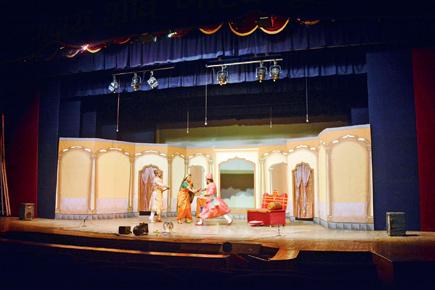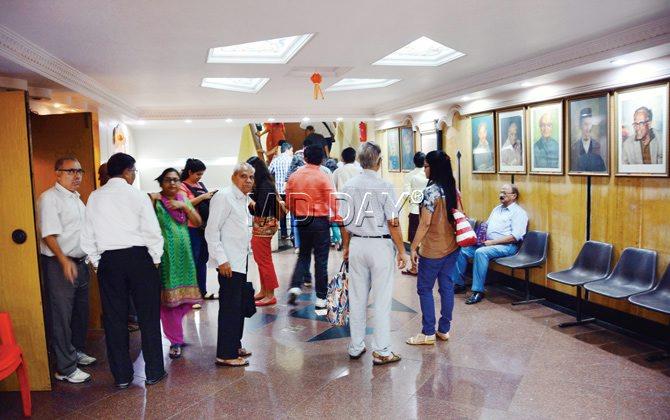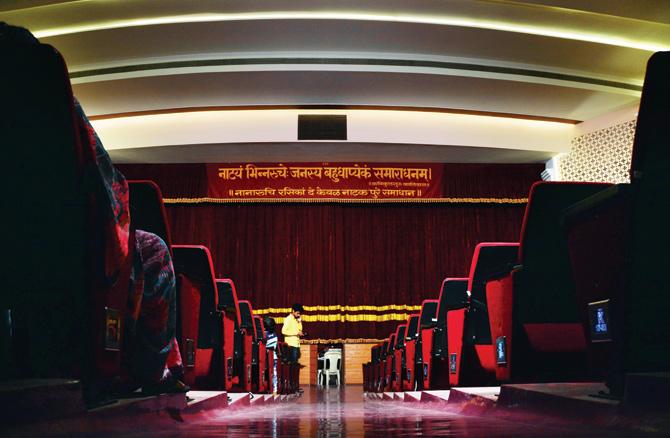As Mumbai celebrates Marathi Rangbhoomi Divas tomorrow, we tour landmark venues and meet leading voices of Marathi theatre, to take stock of their future

The cast of Chava performed in front of 30-odd patrons last Saturday afternoon at Vashi's Vishnudas Bhave auditorium
![]() Circa: October 27, 1952. As the sun sets, over 800 people gather at a ground next to St Theresa School near Kelewadi in Girgaum. Stalwarts like Durga Khote, Nanasaheb Phatak, Ram Marathe and Bhalchandra Pendharkar step onto stage and enthrall a packed house. Bombay Presidency’s Chief Minister Morarji Desai and other dignitaries are seated in the front row as Annasaheb Kirloskar-penned scripts, Saubhadra and Lagnachi Bedi, play out on stage. The day marked the inauguration of an open-air auditorium, supposedly India’s first, as part of Mumbai Marathi Sahitya Sangh, established in 1935 by Dr AN Bhalerao.
Circa: October 27, 1952. As the sun sets, over 800 people gather at a ground next to St Theresa School near Kelewadi in Girgaum. Stalwarts like Durga Khote, Nanasaheb Phatak, Ram Marathe and Bhalchandra Pendharkar step onto stage and enthrall a packed house. Bombay Presidency’s Chief Minister Morarji Desai and other dignitaries are seated in the front row as Annasaheb Kirloskar-penned scripts, Saubhadra and Lagnachi Bedi, play out on stage. The day marked the inauguration of an open-air auditorium, supposedly India’s first, as part of Mumbai Marathi Sahitya Sangh, established in 1935 by Dr AN Bhalerao.

The cast of Chava performed in front of 30-odd patrons last Saturday afternoon at Vashi’s Vishnudas Bhave auditorium. Pic/Sayed Sameer Abedi
ADVERTISEMENT
Fast forward to 2015. On a sleepy Saturday afternoon, the same multi-storeyed building bears a deserted look. A poster of All The Best 2 is pasted at the entrance of the auditorium (constructed in 1960), as pedestrians scurry through the lane outside, a shortcut heading to Charni Road station (E). A carpenter is sawing a wooden plank, perhaps working on a prop for the evening show. “Earlier, we would stage daily performances, but these days, we have only weekend shows,” says Subhash Bhagwat, head of the theatre wing at the institution.

A play performance at Mumbai Marathi Sahitya Sangh’s open-air auditorium in the 1950s
Meanwhile, DD Patil, one of the managers at Parel’s Damodar Hall, built in 1922, rues that the advance booking of Graceful, starring popular Marathi television actress, Aditi Sarangdhar, has managed an advance booking of '2,000. “We had expected Rs 10-20,000. We felt that the auditorium was not drawing in crowds due to its old infrastructure. However, even after renovating it last year, things haven’t changed,” he confesses.

The audience steps out of the auditorium during the interval of a play at Dadar’s Shivaji Mandir. Pics/Bipin Kokate
Enter, weekend theatre
While earlier, Dadar’s 50-year old landmark, Shivaji Mandir would witness houseful boards for plays like Sahi Re Sahi starring Bharat Jadhav and To Mee Navhech, featuring Prabhakar Panshikar, these days, it’s tough to find packed houses on weekends too. “We would host three shows per day (11 am, 3.30 pm and 8 pm); now, we only have Sunday evening shows. On weekdays, we host cultural programmes,” says president, Shashikant Bhalekar.

The revamped Damodar Hall at Parel
A key member of the Marathi theatre industry for 30 years, director-actor Vijay Kenkre, observes, “The attention span of the audience has reduced. It could have happened with the rise of television. Today’s audience is also not that well versed with the language. They prefer more drama and less dialogue and that, too, in spoken dialect. If you provide good content with a strong social theme, viewers will come to watch the play, but only on weekends. On weekdays, they prefer watching
television.” Considering the changing trends, Kenkre, too, is currently developing his popular suspense thriller, Double Game, for the web, in Hindi.
Learning to survive
Not resting on past laurels, the auditoriums are trying new means to sustain. For instance, Prabodhankar Thackeray auditorium leases out its premises for rehearsals and the 18-year old Vishnudas Bhave auditorium at Vashi stages Gujarati plays too. Similarly, Matunga’s Yashwant Natyamandir, that opened its doors to Marathi theatre a decade ago, has also incorporated Hindi and Gujarati performances.
Bhalekar shares, “Once upon a time, theatre was a source of income for us, not any more. We would also earn well from Marathi orchestra performances but that ceased with the advent of musical reality shows. Now, we’ve leased out parts of the property to different tenants, including a bank and a library to earn monthly rent.”
The other stage
Facing heat from more popular venues like Prithvi Theatre and the National Centre for the Performing Arts (NCPA) that regularly host Marathi theatre festivals, these long-standing institutions have also embraced experimental plays. For instance, Alibaba Aani Chaalishitle Chor, a suspense comedy on 40-plus friends, has been performed at Thane’s Gadkari Rangayatan.
Film and theatre actor Dilip Prabhavalkar, who last took to the stage for Kenkre’s Wah Guru! a couple of years ago, says, “The lines between experimental and commercial stage have now blurred. Due to the onslaught of television, the numbers may have dipped but a typical Maharashtrian still loves drama and politics.”
 Subscribe today by clicking the link and stay updated with the latest news!" Click here!
Subscribe today by clicking the link and stay updated with the latest news!" Click here!







